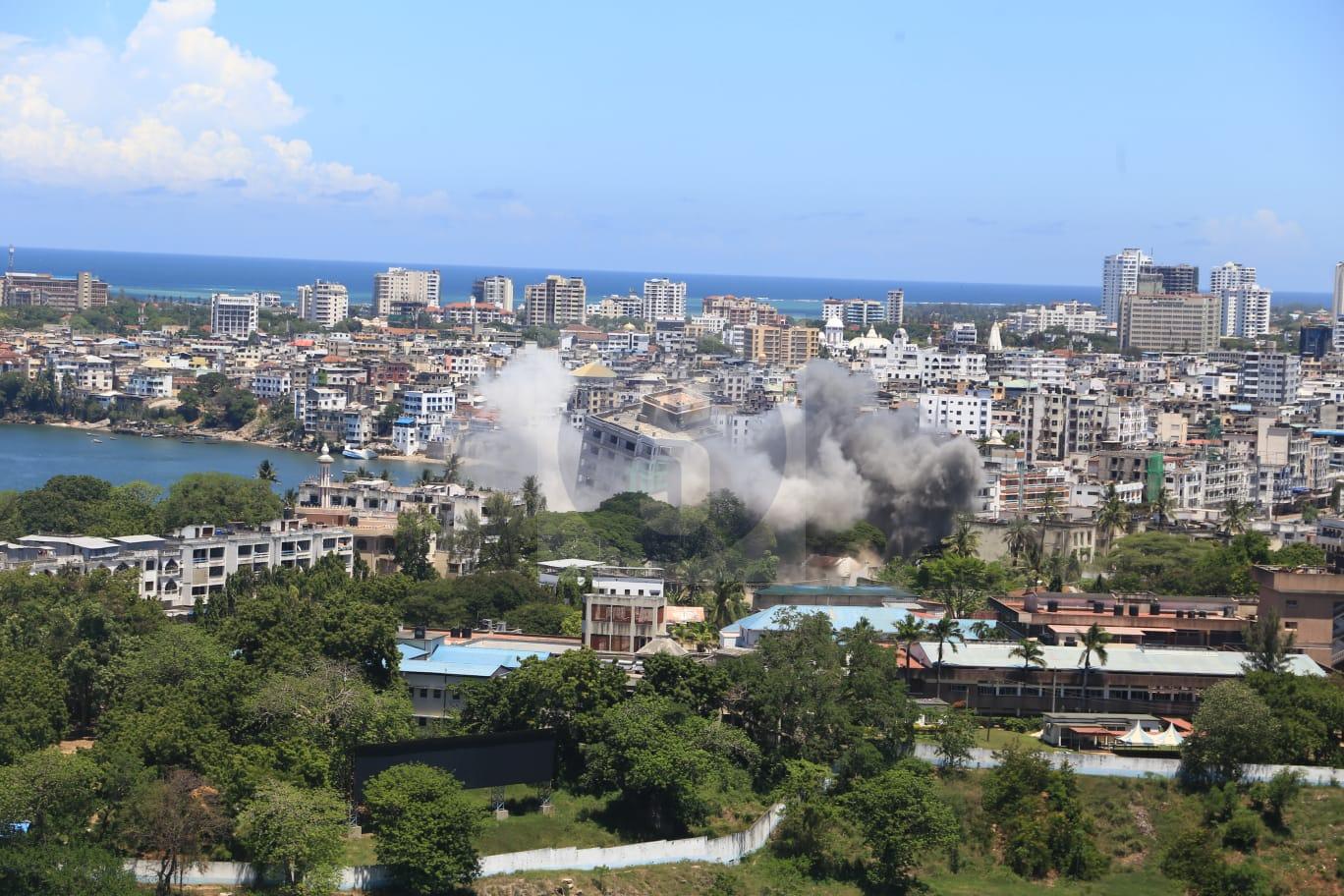

Kenya
Defence Forces officers on Wednesday carried out a controlled
demolition of a nine-storey building that had been declared structurally
unsafe.
This action followed a comprehensive assessment by a multi-agency task force, including the Mombasa County Department of Lands, Urban Planning and Housing, the National Building Inspectorate, the Kenya Defence Forces, and other relevant authorities.
The investigation revealed severe foundational damage, confirming that the building posed an immediate risk to human life and surrounding property.
What is controlled demolition?
Controlled demolition is the strategic, safe dismantling of a building using advanced techniques and equipment.
Unlike traditional demolition, which can be loud, messy, and risky, controlled demolition focuses on precision and safety — especially in densely populated or sensitive areas.
According to the Canada-based Controlled Demolition Organisation, this method is ideal where strict safety, environmental, and regulatory standards must be met.
Key planning elements for a safe demolition
Successful controlled demolition demands careful planning. Essential steps include:
1. Engineering Survey – A qualified expert must assess the building’s condition and determine the likelihood of unexpected collapse.
2. Utility Management – Locate and secure nearby utilities (Call 811 before digging).
3. Fire Safety and Evacuation Plans – To ensure readiness in case of emergencies.
4. Emergency Medical Services – On-site first aid and medical response preparedness.
5. Health Hazard Assessment – Evaluate risks such as asbestos, lead, or mold before demolition begins.
Why controlled demolition matters
Controlled demolition plays a vital role in modern urban development and safety management. Its benefits include:
Safety first
Using specialised equipment and techniques reduces the danger to workers and bystanders, especially in high-risk or densely built areas.
Precision
Ideal for projects where specific parts of a structure must be removed without harming adjacent areas, such as during renovations or partial rebuilds.
Environmental responsibility
This method produces less noise, dust, and debris, reducing environmental impact and ensuring compliance with safety and sustainability standards.
Core techniques in controlled demolition
1. Robotic demolition
Remote-controlled, electric-powered robots can operate in confined or hazardous
spaces, delivering high precision with minimal risk to human workers.
2. Concrete cutting
Techniques like wire sawing, wall sawing, and core drilling allow clean, quiet removal of specific concrete sections—perfect for structural modifications.
3. Selective demolition
When only parts of a structure need to be removed, selective demolition minimises disruption. It’s commonly used in renovations or when preserving key architectural or historical elements.
By understanding and applying controlled demolition techniques, authorities and developers can manage structural risks more effectively, prioritize public safety, and minimize environmental impact.
According to Controlled Demolition Inc., some of the structures which can be demolished using this method include buildings, industrial structures, chimneys, nuclear facilities, sports venues, bridges and marine structures as well as other facilities such as towers and wind turbines
A UK-based company, Hughes and Salvidge says all demolition works are undertaken by a qualified and experienced demolition contractor and should be completed in a controlled environment.
This ensures the safety of the demolition team, other contractors and stakeholders, and the surrounding general public.
The company says that although using explosives as a method to demolish indicates that the building or structure will be ‘blown up’, this is not actually the case.
"Controlled demolition employs a serious of small explosions, strategically placed within a structure, progressively detonated encouraging a collapse by weakening or removing critical supports," Hughes and Salvidge says.
"Explosives on the lower floors then initiate a controlled collapse and the building fails under its own weight, succumbing to gravity," it explains.
According to Hughes and Salvidge, tall buildings, such as tower blocks, are typically seen as the main buildings demolished by controlled demolition.
It is essentially more cost and time-efficient to bring down a building of significant size and height using explosives, it says.
It however says that how appropriate this method will be depends on the surrounding area as well as whether there are other buildings in close proximity, and tenants and/or residents occupying those buildings.
The local environment and wildlife are also taken into consideration.
It says the demolition of bridges over in-use roadways and waterways by controlled demolition ensures minimum disruption to the general public and transportation systems.
"Road closures and waterway traffic halts are put in place for preparation, detonation, and debris clearing."
The Mombasa building, located in the Kilifi area of Mvita Sub-County, was on the brink of collapse due to serious structural and foundational defects.
A portion of the building had already sunk after an unauthorized borehole was dug around its foundation.
On Tuesday afternoon, both national and county governments announced that KDF would carry out the demolition using explosives — a decision that sparked concern among residents, many of whom viewed the operation as risky.












